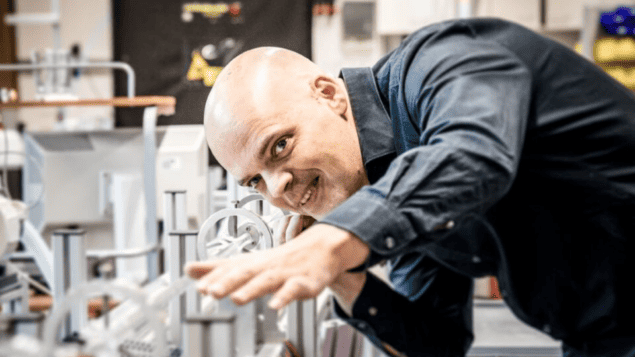
Pumping patterns that mimic the human heartbeat can drastically reduce turbulence in a fluid that is pumped through pipes, researchers in Austria have discovered. Through a simple set of experiments, Björn Hof and colleagues at the Institute of Science and Technology Austria showed how pumping pulses interspersed with rest periods could lead to the development of far more efficient pumping techniques.
The pumping of fluids plays crucial roles in industry, agriculture and the provision of utilities such as water. Indeed, it is estimated that 10% of all electrical energy consumed globally is used for pumping. Because of this energy intensity, people have been trying to develop better and more efficient pumps for a very long time. However, experts still do not fully understand how to optimize the pumping process.
For over a century, researchers have understood that turbulence in a pipe will increase friction between pipe and fluid, thereby reducing pumping efficiency. While there has been some progress in developing methods for eliminating turbulence, it has not been and easy problem to solve.
Difficult in practice
“In practice, the methods we have developed so far turned out to be not so useful,” Hof explains. “Even if we can eradicate turbulence in some part of the flow, turbulence can be triggered a little further downstream by dents, bends, or other imperfections in pipes, and the whole effect is lost.”
Instead of exploring novel designs of pumps or pipes, Hof and colleagues have focused on controlling the velocity of the fluid passing through them. “We knew from our transition work that a change in the time averaged velocity profile can be very efficient in suppressing turbulence,” says Hof. “This is far easier than instantaneously reacting to velocity changes, a turbulence control approach used by many previous studies.”
To test their idea, the team constructed a simple apparatus in which water is pumped through a clear pipe. A customized syringe pump is used to carefully control its flow rate. To observe the flow patterns that emerged, they seeded the water with reflective particles. Shining a laser beam down the centre of the pipe allowed the team to take snapshots of the fluid at regular time intervals.
Remarkably similar
Using this setup, the researchers quantified the degree of turbulence resulting from a variety of pulsed flow patterns. They found that the pumping pattern that consistently generated the least turbulence was remarkably similar to the flow pattern of blood driven by the human heart.
“Overall, we found that the best performance is found for a waveform that is very close to that found in the aorta, where large fluctuation and drag levels would be harmful for its inner lining of cells,” Hof explains.

Tiny 3D-printed vacuum pump could give mass spectrometry a boost
In our blood vessels, fast-flowing pulses generated by the heart’s regular contraction are separated by brief rest periods, where the heart relaxes to allow its chambers to fill up with blood. When they included this resting phase in their pumping pattern, Hof’s team found that turbulence in the pipe was almost completely eliminated for flow speeds comparable to those in the aorta. Even at far higher flow speeds, the amount of drag created by turbulence was reduced by more than 25%.
The researchers acknowledge there will be many challenges to overcome before heart-inspired technology can be incorporated into practical pumping applications. “For now, current pumps may not be suitable to achieve the required waveform, and further studies will also be needed to see if gains persist at even higher flows speeds,” Hof says.
The team also plans to look for other flow patterns that could be even better at reducing turbulence – especially at higher flow speeds. Through further research, the team hopes that new pumping techniques could be developed that significantly improve the efficiency of pumping – reducing both its cost and environmental impact.
The research is described in Nature.
